transmission FIAT BARCHETTA 2003 1.G Owners Manual
[x] Cancel search | Manufacturer: FIAT, Model Year: 2003, Model line: BARCHETTA, Model: FIAT BARCHETTA 2003 1.GPages: 170, PDF Size: 3.55 MB
Page 83 of 170
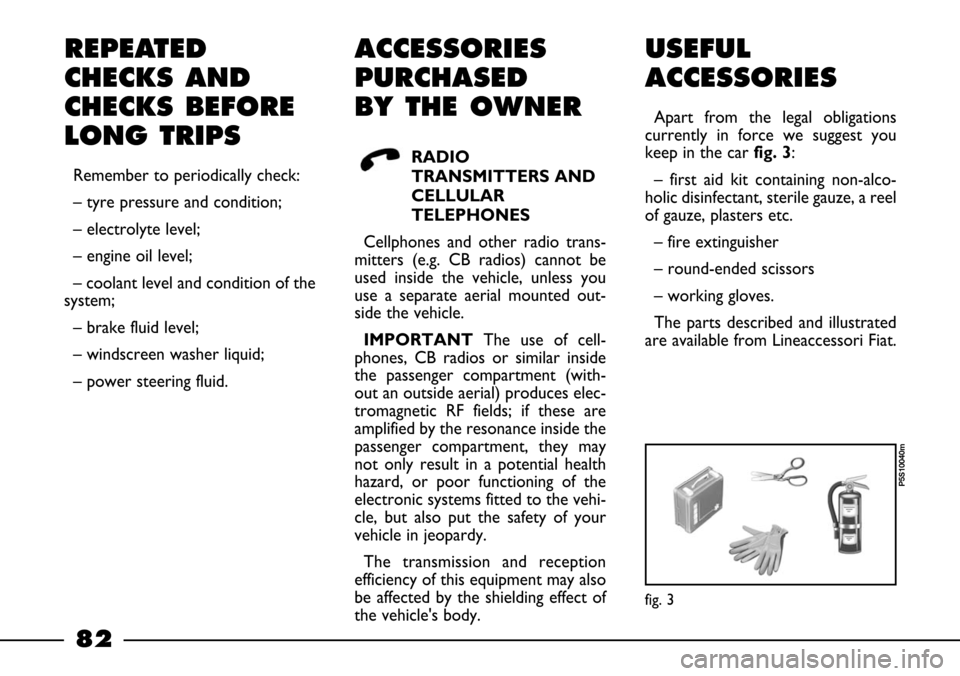
82
REPEATED
CHECKS AND
CHECKS BEFORE
LONG TRIPS
Remember to periodically check:
β tyre pressure and condition;
β electrolyte level;
β engine oil level;
β coolant level and condition of the
system;
β brake fluid level;
β windscreen washer liquid;
β power steering fluid.
ACCESSORIES
PURCHASED
BY THE OWNER
RADIO
TRANSMITTERS AND
CELLULAR
TELEPHONES
Cellphones and other radio trans-
mitters (e.g. CB radios) cannot be
used inside the vehicle, unless you
use a separate aerial mounted out-
side the vehicle.
IMPORTANTThe use of cell-
phones, CB radios or similar inside
the passenger compartment (with-
out an outside aerial) produces elec-
tromagnetic RF fields; if these are
amplified by the resonance inside the
passenger compartment, they may
not only result in a potential health
hazard, or poor functioning of the
electronic systems fitted to the vehi-
cle, but also put the safety of your
vehicle in jeopardy.
The transmission and reception
efficiency of this equipment may also
be affected by the shielding effect of
the vehicle's body.
USEFUL
ACCESSORIES
Apart from the legal obligations
currently in force we suggest you
keep in the car fig. 3:
β first aid kit containing non-alco-
holic disinfectant, sterile gauze, a reel
of gauze, plasters etc.
β fire extinguisher
β round-ended scissors
β working gloves.
The parts described and illustrated
are available from Lineaccessori Fiat.
fig. 3
P5S10040m
Page 86 of 170
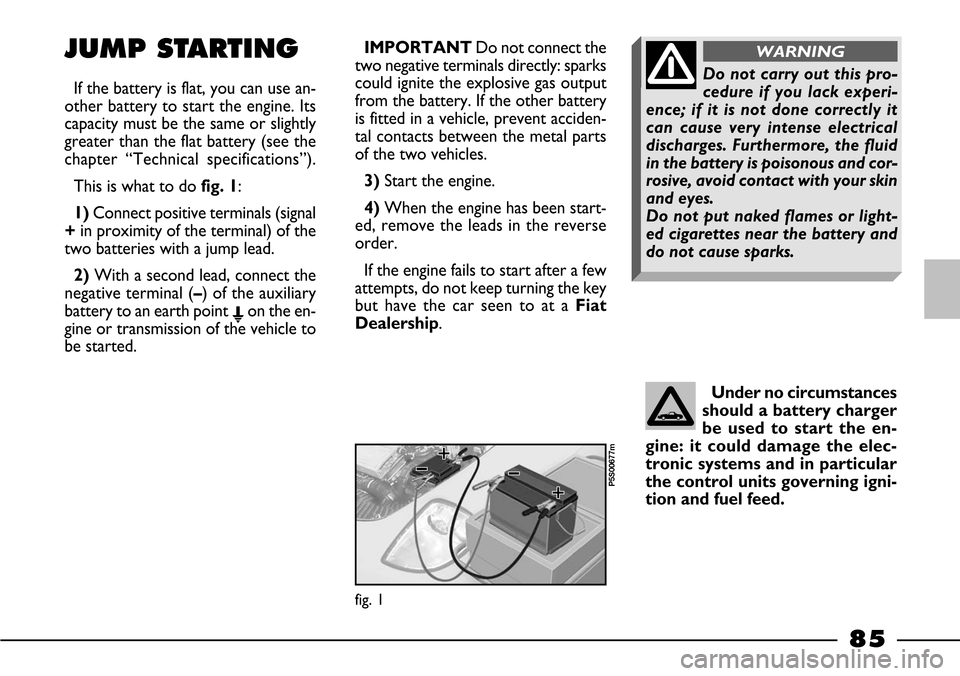
85
Under no circumstances
should a battery charger
be used to start the en-
gine: it could damage the elec-
tronic systems and in particular
the control units governing igni-
tion and fuel feed.
JUMP STARTING
If the battery is flat, you can use an-
other battery to start the engine. Its
capacity must be the same or slightly
greater than the flat battery (see the
chapter βTechnical specificationsβ).
This is what to do fig. 1:
1)Connect positive terminals (signal
+in proximity of the terminal) of the
two batteries with a jump lead.
2)With a second lead, connect the
negative terminal (β) of the auxiliary
battery to an earth point Eon the en-
gine or transmission of the vehicle to
be started.IMPORTANTDo not connect the
two negative terminals directly: sparks
could ignite the explosive gas output
from the battery. If the other battery
is fitted in a vehicle, prevent acciden-
tal contacts between the metal parts
of the two vehicles.
3)Start the engine.
4)When the engine has been start-
ed, remove the leads in the reverse
order.
If the engine fails to start after a few
attempts, do not keep turning the key
but have the car seen to at a Fiat
Dealership.
fig. 1
P5S00677m
Do not carry out this pro-
cedure if you lack experi-
ence; if it is not done correctly it
can cause very intense electrical
discharges. Furthermore, the fluid
in the battery is poisonous and cor-
rosive, avoid contact with your skin
and eyes.
Do not put naked flames or light-
ed cigarettes near the battery and
do not cause sparks.
WARNING
Page 116 of 170
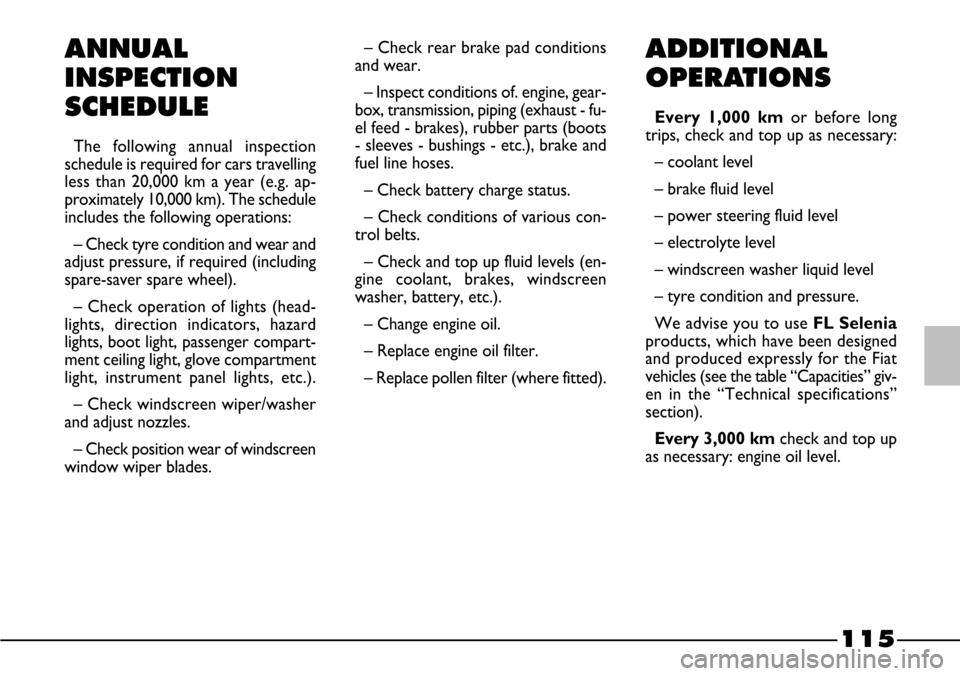
115
ANNUAL
INSPECTION
SCHEDULE
The following annual inspection
schedule is required for cars travelling
less than 20,000 km a year (e.g. ap-
proximately 10,000 km). The schedule
includes the following operations:
β Check tyre condition and wear and
adjust pressure, if required (including
spare-saver spare wheel).
β Check operation of lights (head-
lights, direction indicators, hazard
lights, boot light, passenger compart-
ment ceiling light, glove compartment
light, instrument panel lights, etc.).
β Check windscreen wiper/washer
and adjust nozzles.
β Check position wear of windscreen
window wiper blades.
ADDITIONAL
OPERATIONS
Every 1,000 kmor before long
trips, check and top up as necessary:
β coolant level
β brake fluid level
β power steering fluid level
β electrolyte level
β windscreen washer liquid level
β tyre condition and pressure.
We advise you to use FL Selenia
products, which have been designed
and produced expressly for the Fiat
vehicles (see the table βCapacitiesβ giv-
en in the βTechnical specificationsβ
section).
Every 3,000 km check and top up
as necessary: engine oil level. β Check rear brake pad conditions
and wear.
β Inspect conditions of. engine, gear-
box, transmission, piping (exhaust - fu-
el feed - brakes), rubber parts (boots
- sleeves - bushings - etc.), brake and
fuel line hoses.
β Check battery charge status.
β Check conditions of various con-
trol belts.
β Check and top up fluid levels (en-
gine coolant, brakes, windscreen
washer, battery, etc.).
β Change engine oil.
β Replace engine oil filter.
β Replace pollen filter (where fitted).
Page 136 of 170
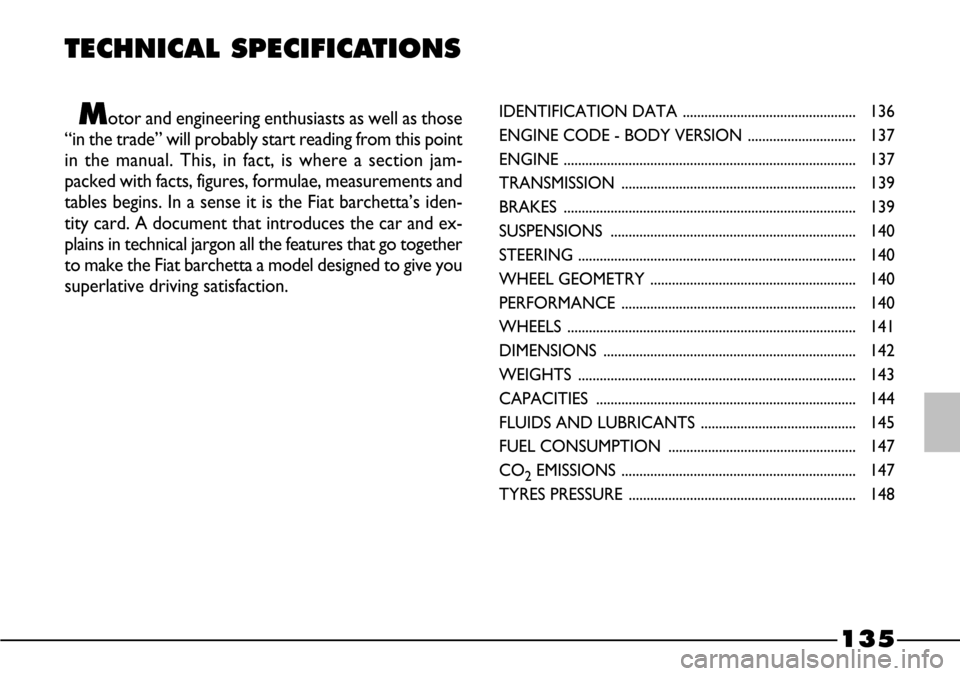
135
TECHNICAL SPECIFICATIONS
Motor and engineering enthusiasts as well as those
βin the tradeβ will probably start reading from this point
in the manual. This, in fact, is where a section jam-
packed with facts, figures, formulae, measurements and
tables begins. In a sense it is the Fiat barchettaβs iden-
tity card. A document that introduces the car and ex-
plains in technical jargon all the features that go together
to make the Fiat barchetta a model designed to give you
superlative driving satisfaction.IDENTIFICATION DATA ................................................ 136
ENGINE CODE - BODY VERSION .............................. 137
ENGINE ................................................................................. 137
TRANSMISSION ................................................................. 139
BRAKES ................................................................................. 139
SUSPENSIONS .................................................................... 140
STEERING ............................................................................. 140
WHEEL GEOMETRY ......................................................... 140
PERFORMANCE ................................................................. 140
WHEELS ................................................................................ 141
DIMENSIONS ...................................................................... 142
WEIGHTS ............................................................................. 143
CAPACITIES ........................................................................ 144
FLUIDS AND LUBRICANTS ........................................... 145
FUEL CONSUMPTION .................................................... 147
CO
2EMISSIONS ................................................................. 147
TYRES PRESSURE ............................................................... 148
Page 140 of 170
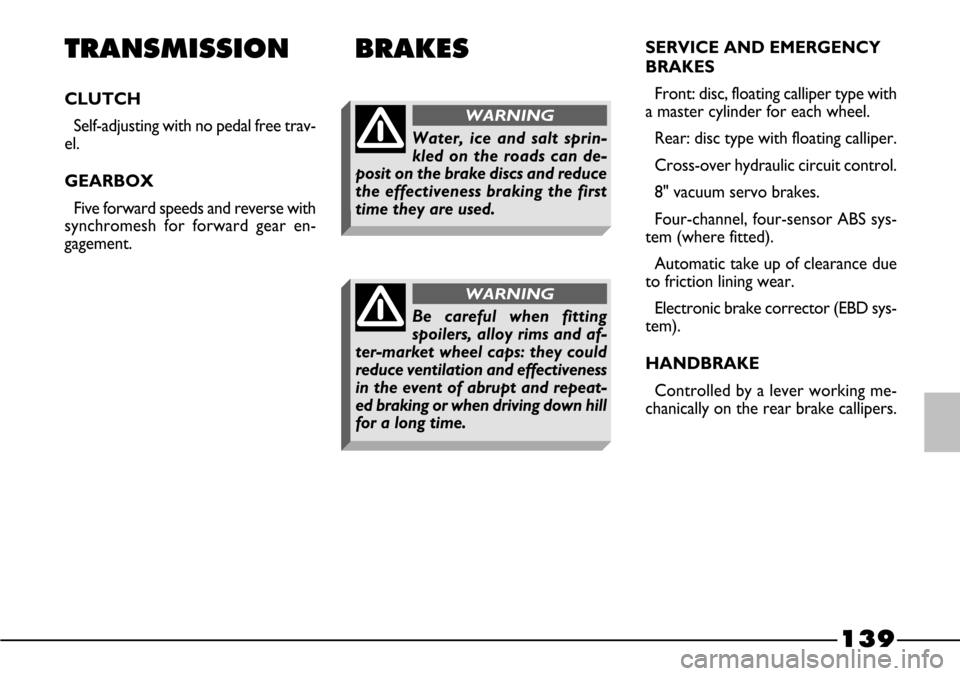
139
TRANSMISSION
CLUTCH
Self-adjusting with no pedal free trav-
el.
GEARBOX
Five forward speeds and reverse with
synchromesh for forward gear en-
gagement. SERVICE AND EMERGENCY
BRAKES
Front: disc, floating calliper type with
a master cylinder for each wheel.
Rear: disc type with floating calliper.
Cross-over hydraulic circuit control.
8" vacuum servo brakes.
Four-channel, four-sensor ABS sys-
tem (where fitted).
Automatic take up of clearance due
to friction lining wear.
Electronic brake corrector (EBD sys-
tem).
HANDBRAKE
Controlled by a lever working me-
chanically on the rear brake callipers.
BRAKES
Water, ice and salt sprin-
kled on the roads can de-
posit on the brake discs and reduce
the effectiveness braking the first
time they are used.
WARNING
Be careful when fitting
spoilers, alloy rims and af-
ter-market wheel caps: they could
reduce ventilation and effectiveness
in the event of abrupt and repeat-
ed braking or when driving down hill
for a long time.
WARNING
Page 147 of 170

Transmission lubricants
and grease
146
Specifications of fluids and lubricants to use
for best car operation
Synthetic oil SAE 75W-80 EP. It complies with the
specifications API GL5, MIL - L - 2105 D LEV.
ATF DEXRON II D LEV, SAE 10W oil type
Molybdenum disulphide, lithium-soap based grease,
water resistant, NLGI = 2 consistency
Synthetic fluid, NHTSA nΒ° 116, DOT 4, ISO 4925
SAE J 1703, CUNA NC 956 - 01
Protective with anti-freeze action, for inhibited mono ethylene
glycol based cooling systems, CUNA NC 956 - 16
Alcohol and surfactants mixture CUNA NC 956 - IIRecommended fluids
and lubricants
TUTELA CAR
ZC 75 SYNTH
TUTELA GI/A
TUTELA MRM 2
TUTELA TOP 4
PARAFLU
11
TUTELA
PROFESIONAL
SC 35Applications
Manual gearbox
and differentials
Hydraulic power
steering
CV joints
Hydraulic brake
and clutch
Proportion: 50-50 mix
down to β35Β°C
To be used pure or
diluted in windshield
wiper washing systems Use
Brake liquid
Radiator antifreeze
Windscreen/
window washer fluid
Page 162 of 170

161
β homologation codes....... 156
Rear fog lights
β controls ............................ 41
β bulb replacement ........... 97
Rear windowing (cleaning) . 133
Rearview mirrors
β electric............................... 20
β external ............................. 20
β internal .............................. 20
Rev counter............................. 28
Repeated checks ................... 82
Reversing lights ....................... 97
Rubber piping .......................... 128
Safe driving
β driving at night ................. 73
β driving in the rain ............ 74
β before getting behind
the wheel .......................... 72
β driving in fog .................... 74
β driving in the mountains 75
β driving on snow and ice 75
β driving with ABS.............. 75
β when travelling ................ 72
Seat belts
β general information ........ 22β maintenance ..................... 23
β use ...................................... 21
Seats
β adjustment ........................ 18
β cleaning.............................. 134
Servicing ................................... 111
β additional operations ..... 115
β annual inspection schedule 115
β scheduled service............ 112
β Service Schedule ............. 113
Side/taillights
β controls ............................ 38
β front bulb replacement 93
β rear bulb replacement .. 96
Snow tyres ............................... 80-141
Spark plugs............................... 126
Specifications ........................... 135
Speedometer........................... 28
Starting the engine
β jump starting .................... 85
β bump starting ................... 86
β emergency start-up ........ 84
β ignition switch.................. 17
β stopping the engine ........ 69
β warming up a recently
started engine .................. 69Steering column lock............. 18
Steering column stalks
β left-hand stalk .................. 38
β right-hand stalk................ 39
Steering wheel ........................ 19
Steering..................................... 140
Storing the car ........................ 81
Sun visors ................................. 43
Suspensions ............................. 140
Symbols .................................... 9
Technical specifications.... 135
Third brake light
(bulb replacement) ............... 96
Tools............................................. 88
Top speeds .................................. 140
Towing a trailer
β tow hitch installation ......... 152
β warnings................................ 79
Towing the car ........................... 108
Transmission (ratios) ................ 139
Transporting children
in safety .................................... 24
Tyre pressure ............................. 148
Tyres ..................................... 126-148